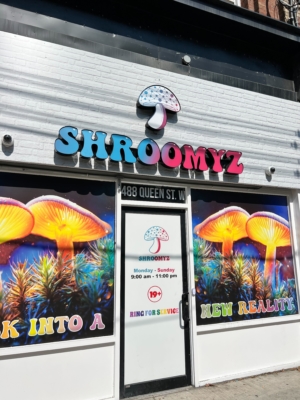
So here we are at the end of another year that feels like it flew by in a flash.
While 2022 was a year that most of us operating businesses in the psychedelics sector would love to toss in a dumpster, there were actually several important developments that, if for nothing else, demonstrated the painfully and frustratingly slow progress that continues to be made for a nascent industry in development.
2022 was a wild ride for the public psychedelics market sector! However, rather than it feeling like an uplifting ride down the Pacific Coast Highway at sunset, the year felt more like a wild, out-of-control rollercoaster ride built by an evil sadist.
Yes. Unfortunately, many of us operating businesses in the psychedelics sector were stuck seeing red for much of the year. The sharp downturn even claimed a few victims as companies like Havn Life Sciences and Mind Cure Health, who each had demonstrated encouraging potential over the past couple of years as emerging biotech leaders, crumpled and folded under the pressures and challenges of a market where a once steady flow of investment capital was scaled back to a very modest trickle.
While other early psychedelics industry leaders such as MindMed, Cybin, Compass Pathways, and ATAI Life Sciences have all seemingly managed to survive the bloodbath that was the 2022 psychedelic public market sector, much like Jon Snow miraculously surviving the “Battle of the Bastards,” the question now becomes whether the darkest days are now behind us? Or is winter still coming?
Despite all the obstacles, disappointments, and frustration that we experienced throughout 2022, there is no way you would catch me writing it off as a total loss.
Although there weren’t any traditional or outright, obvious bellwether moments for the psychedelics industry in 2022, there most definitely were a handful of key developments and, perhaps most importantly, valuable lessons that we can carefully remove from the smoldering pile of rubble and take with us into 2023 and beyond.
The Psychedelic Retail Grey Market Gets Bold with Testing Boundaries
Regardless of the growing pains that the commercial psychedelic market sector is still dealing with, it’s tough to argue with the fact that psychedelics have become a hot topic across society both here in North America and abroad, over the last couple of years.
A renewed interest and fascination with these mind-altering substances has undoubtedly been spurred on by a slew of traumatizing and extremely upsetting events that have recently unfolded in our world and have taken a very serious toll on our mental and physical state of wellbeing.
On the other end of the spectrum we saw notable, and in some instances controversial, figureheads like Joe Rogan, Mike Tyson, and Gwyneth Paltrow come out in recent years and vouch for the healing and restorative wonders of psychedelics. For better or worse, this has helped to create demand amongst hordes of self-proclaimed alpha males and suburban white women who all generally share one very important thing in common: disposable income.
The very obvious problem here is that buying a bag of magic mushrooms isn’t usually as convenient as buying a pumpkin spiced latte at your neighborhood Starbucks.
However, for those of us fortunate to live in a city or state where recreational marijuana has been legalized, scoring a pre-roll of your favorite ganja has become almost as easy and convenient as it is to score that first PSL of fall.
As someone who lived in Los Angeles prior to recreational marijuana becoming a thing, I can easily recall the days of the grey retail cannabis marketplace. I remember dispensaries opening up illegally in a variety of different retail spaces throughout LA County. Most of them would stay open for a few-to-several weeks only to be raided and shut down by authorities once they were no longer able to operate under the radar. Or until the neighborhood Karen would rat them out.
Nonetheless, once one dispensary was forcefully shut down, a new one would inevitably pop in a matter of days. And this cycle would persist for years up until recreational marijuana was legalized in the state of California in 2016.
Perhaps the two most notable retail psychedelic shops that opened their doors for business this year were Shroomyz which opened in September on Queen St. in Toronto and Shroom House which opened its doors in October in the West Burnside neighborhood of Portland, OR.

Both shops gained immediate popularity amongst locals in search of the psychoactive fungi. In fact, in the short time it was open for business, eager shoppers at Shroom House would often wait in lines of up to six hours.
On the morning of December 8th, however, Portland Police raided and shut down Shroom House. The two men who owned the shop have since been arrested and charged.
Shroomyz, on the other hand, which was last raided by authorities in Toronto on November 13th, has since reopened to the public and appears to be standing its ground in the greyest of all gray areas and in clear defiance of the Controlled Drugs and Substances Act.
Only time will tell just how many more aspiring entrepreneurs exist across North America, willing to risk it all by opening up other psychedelic retail shops like Shroomyz and Shroom House. By simply judging the growing number of psychedelic-related products ranging from at-home mushroom growth kits, to magic mushroom chocolate bars that continue to surface across the interwebs and social media, and that I, personally, come across with my own four eyes every day, it’s starting to feel like the proverbial genie, as it relates to the psychedelic retail gray market, is quickly squeezing itself too far out of the bottle to be put back in.
Painfully Slow, Yet Continued Progress Seen with Legislation
A few years ago, as I was eagerly beginning my foray into the wonderful world of psychedelics, a good friend warned me of the many years that lay ahead before any substantial progress would be made with psychedelics from a legislation standpoint. But he also told me to keep my eyes on the state of Colorado which, of course, became the first state in the US to legalize the recreational sale of cannabis in 2012.
A full ten years after that momentous and wildly historic occasion, it’s easy, now in retrospect, to see how that was the first of many previously perceived, immovable dominos, to fall as several other states across the US have since passed similar legislation approving recreational cannabis.
With all of this in mind, you can imagine my cautious, yet optimistic delight in seeing voters in the state of Colorado pass Proposition 122 this past November. The measure, which has some inherent similarities, yet notable differences, to the Psilocybin Therapy Initiative passed by voters in the state of Oregon in 2020, will decriminalize psychedelic mushrooms and by 2024 and will allow the supervised use of two of the prodrugs found in the mushrooms, psilocybin and psilocin, at state-regulated “healing centers.”
And while this doesn’t necessarily mean we are any closer to a scenario whereby folks in Colorado can turn their frowns upside down after another painfully disappointing Broncos season by legally purchasing magic mushrooms at a local shop, it does, however, signal an important step closer in terms of some type of accessibility to the joyous wonders of magic mushrooms.
More importantly, Prop 122 will help bring many Coloradans who are struggling with various mental health conditions like depression, PTSD, anxiety, and even addiction, several steps closer to accessing new and potentially life changing treatment options.
It is also another important step forward in the fight to tear down the stigma that has been wrongfully attached to psychedelics due in large part to good ol’ Dick Nixon’s flawed War on Drugs launched in the 1970’s.
After legalizing recreational cannabis in 2012, many pearl clutching Americans and politicians assumed that the state would fall into complete anarchy and the system would all come crashing down. And when none of that even came close to happening, the perception surrounding cannabis started to change.
The only way society is going to start to lose its fear and uncertainty surrounding psychedelics is by seeing that their introduction into everyday life, whether medicinally or otherwise, is not necessarily going to be the catalyst for triggering the apocalypse.
Although there is still a ton of work that needs to be done in order to refine and establish a reasonably effective framework for both measures in Oregon and Colorado, the fact that there is even a legal track to put them on is a ginormous step in the right direction.
Naturally, the next state to keep our eyes on is California. If any real progress is going to be made in the Golden State with psychedelics, it’s likely going to be due in large part to the persistence and determination of CA Senator, Scott Wiener. Last year, Wiener introduced SB 519 which was aimed at decriminalizing a variety of psychedelic substances. After the state Senate proved successful in passing the bill and two Assembly Committees followed suit, it became stalled in the final committee hurdle – Assembly Appropriations.
Wiener, however, would go back to the drawing board, and just this month, introduced SB 58, a refined and revised version of SB 519 that intends to decriminalize the possession and personal use of certain psychedelic drugs.
According to Wiener’s office, SB 58 is backed by a broad coalition, including combat veterans and is even sponsored by Heroic Hearts Project.
In the coming months, SB 58 will be put to the test in order to determine whether the revisions that were introduced will prove to be enough to avoid a similar fate to that of its predecessor, SB 519.
Finally, while it wasn’t necessarily a key win on the legislative front, it is worth providing our good friends to the north in Quebec with a quick shout out for becoming the first province to agree to cover psilocybin-assisted therapy under medical insurance.
This is yet another clear sign of the increasing demand for psilocybin therapy in both Canada and the United States. The people want it. And if history has taught us one thing, it’s that with a little bit of persistence and momentum, the people typically find a way to get what they want in some form or another.
Psychedelic Drug Clinical Trials Continue to March Forward (albeit at a slow and steady pace)
While the road ahead for decriminalizing psychedelics at city and state levels remains very clouded and uncertain, the path for certain psychedelic drugs becoming approved and accepted as treatment options for certain mental and physical disorders is bit less treacherous.
Without a doubt, the capacity of psychedelics to become a multi-billion dollar industry if they are accepted by Big Pharma is the driving force behind this entire emerging sector.
In the last few years, investors have not simply been blindly throwing millions of dollars into the psychedelics industry in anticipation that laws may eventually allow us to consume psychedelics without fear of consequence. Rather, they are actively working towards changing regulations so we can explore and benefit from these substances safely within our homes.
Nope. The overwhelming vast majority of them have been putting their money into the many different biotech and drug development companies that have sprouted up in recent years with the expectation that some of these drugs will eventually achieve approval from the FDA and become positioned to tap into the ridiculously wealthy world of pharmaceuticals.
It is disheartening for some investors to come face-to-face with the extended and exhaustive process of shepherding a drug through clinical trials, particularly when it pertains to psychedelics. Unfortunately, agencies such as the FDA tend to view these drugs as being either hazardous or inadequate until research can demonstrate otherwise.
The good news is that investors can be assured that the millions of dollars they’ve been pouring into biotech companies in recent years are being utilized for beneficial purposes, as evidenced by encouraging results.
Earlier this year, COMPASS Pathways announced that The New England Journal of Medicine, the world’s leading peer-reviewed medical journal, published the positive results from its Phase 2b clinical trial of COMP360 psilocybin therapy for treatment-resistant depression (TRD) – the largest study of its kind.
According to the published report, after a single 25mg dose of COMP360 psilocybin, in combination with psychological support, 29.1% of participants with treatment-resistant depression were in remission by week 3. COMPASS Pathways hopes to move into the Phase 3 portion of the study very soon.
The collective eyes, however, of the entire psychedelic sector remain fixated on the folks over at the Multidisciplinary Association for Psychedelic Studies (“MAPS”) as we await, with abated breath, for the results from their second Phase 3 trial of MDMA-assisted therapy for PTSD.
This clinical trial is currently in the most advanced position of any psychedelic-related drug trials, and is on track to be reviewed and potentially approved by the FDA. The psychedelics industry is keeping a close eye on MAPS’ headquarters over the next several months much like how Catholics keep their eyes glued to the smoke signal coming out of the chimney of the Sistine Chapel waiting for confirmation that a new Pope has been selected. As we look ahead to 2023, our anticipation and hope is that Rick Doblin, who is basically the Pope of psychedelics, will announce the successful Phase 3 trial of MDMA-assisted therapy for PTSD as approved by the FDA.
Other “Interesting” Notes and Observations from the Psychedelics Industry in 2022
As I mentioned at the opening of this piece, 2022, by and large, was a frustratingly slow burn for the psychedelics market sector.
Nonetheless, as the oft-repeated expression states, “Rome wasn’t built in a day.”
It is essential, however, to recognize the remarkable progress made with psychedelics. Just a few years ago, there really wasn’t any visible path forward for psychedelics to even become a market sector or industry. Today, with progress being made on legislative fronts, multiple clinical trials inching closer to FDA approval, and people simply letting go of the misconceptions and fear they’ve felt towards psychedelics, we find ourselves in a situation where the impossible doesn’t feel so impossible anymore.
There is no doubt that there are still several challenges and factors to consider in order to make sure psychedelic-assisted therapy becomes a viable, accessible treatment option for all individuals, regardless of their socioeconomic background. Not to mention, BIPOC communities have been disproportionately affected by the failed and overtly racist War on Drugs.
As the psychedelic industry continues to rise, many questions remain unanswered about how best to adequately recognize and compensate indigenous people and communities for their role in discovering the potential benefits of psychedelics.
Even though we have more questions than answers right now, I am encouraged by a single fact: the conversations about these vital topics are finally taking place. After talking to many people in the psychedelic community, it’s amazing to see that progress is being made and dialogues are deepening.
Nowhere was this more evident to me than at the Remind Psychedelics Business Forum that took place at MJBizCon in Las Vegas this November.
Indigenous reciprocity, accessibility for all, and education were all topics that were discussed in great detail. It appears that the pillars of this sector are united in their aim to ensure psychedelics take on a different approach than the cannabis industry. Genuinely dedicated educators, early leaders and advocates have committed themselves to ensuring there is a difference when it comes to psychedelics.
When we step back to view the market sector as a whole, it is difficult to predict exactly what 2023 will bring. However, with many of the “FOMO” investors that jumped head first into this sector without understanding or acknowledging the challenges and timelines the psychedelics industry had to confront, now being flushed out of this sector, there’s a good chance that we experience a bit of stability over the next several months.
Despite the bloodbath that was 2022 for many public companies in the psychedelics sector, the long-term potential of this industry hasn’t really changed. In fact, the only thing that has possibly changed is that the will of the people to gain access to psychedelics, whether for recreational or medicinal purposes, seems to be picking up steam. And perhaps rightfully so. We live in a society that is tired of being tired and frustrated with constantly being frustrated. Consequently, the majority of us are desperate for a change, something that can break through the barriers standing in between ourselves and a life that is just more fulfilling.
So why not psychedelics?
Here’s to a less turbulent 2023!





